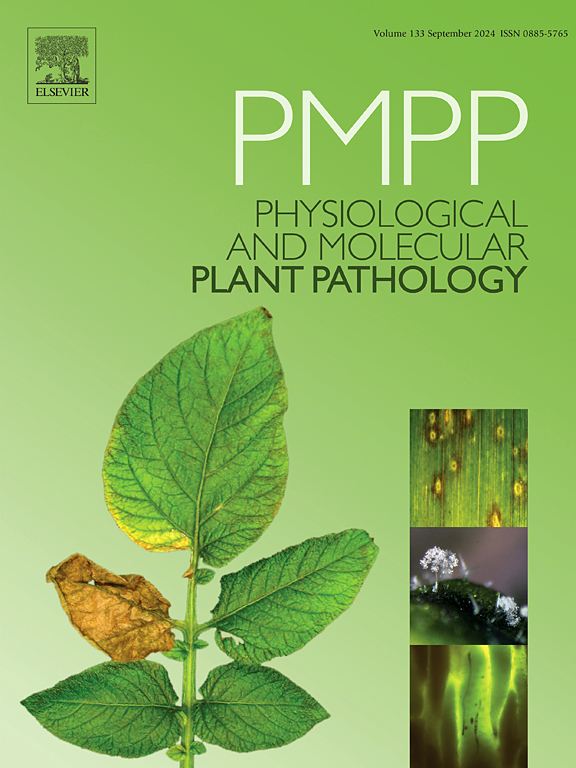Analysis of novel volatile compounds, plant-beneficial traits, and genomic features of the endophyte Bacillus velezensis ITCE1 and its crosstalk with Trichoderma
IF 3.3
3区 农林科学
Q2 PLANT SCIENCES
引用次数: 0
Abstract
The use of agrochemicals is a contributing factor to global climate change, making the development of alternative products urgently needed for sustainable agriculture. Therefore, in this study, we isolated and performed genomic characterization of a plant-beneficial endophytic bacterium, identified as Bacillus velezensis strain ITCE1. In vitro assays confirmed that ITCE1 promotes seed germination, antagonizes fungal pathogens and promotes plant growth under greenhouse conditions (e.g. chlorophyll content, root length, total dry weight). These effects were enhanced by interaction with the beneficial fungus Trichoderma atroviride. The volatile metabolite 2,4-hexadiyne, produced exclusively by ITCE1, consistently increased in abundance from 26.66 % to 94.19 % when Bacillus velezensis was co-cultivated with T. atroviride. This is the first report of 2,4-hexadiyne as a volatile produced by a bacterium with potential biocontrol and plant growth-promoting effects. Additionally, the genome of ITCE1 (4 Mb in size, 46.2 % GC content), its taxonomic affiliation, phylogenetic analyses, and pan-genome profiling with other B. velezensis strains are reported. Finally, genome mining for antimicrobial metabolites revealed the presence of genes involved in the biosynthesis of indole-3-acetic acid, cytokinins, lipopeptides, and siderophores, as well as genes associated with tolerance to osmotic, nitrosative, and other environmental stresses. These findings highlight the broad genetic and functional potential of strain ITCE1 as a bioinoculant for sustainable agriculture.
内生芽孢杆菌ITCE1的挥发性化合物、植物有益性状和基因组特征及其与木霉的串扰分析
农用化学品的使用是导致全球气候变化的一个因素,因此开发替代产品是可持续农业的迫切需要。因此,在这项研究中,我们分离了一种植物有益的内生细菌,并进行了基因组鉴定,鉴定为芽孢杆菌velezensis菌株ITCE1。体外实验证实,ITCE1在温室条件下促进种子萌发,拮抗真菌病原体,促进植物生长(如叶绿素含量、根长、总干重)。这些效果通过与有益真菌atroviride木霉的相互作用而增强。与T. atroviride共培养时,ITCE1产生的挥发性代谢物2,4-己二炔的丰度从26.66%持续增加到94.19%。这是首次报道由细菌产生的具有潜在生物防治和促进植物生长作用的挥发物2,4-己二炔。此外,还报道了ITCE1(大小为4mb, GC含量为46.2%)的基因组,其分类关系,系统发育分析以及与其他贝氏螺旋体菌株的泛基因组分析。最后,对抗菌代谢物的基因组挖掘揭示了参与吲哚-3-乙酸、细胞分裂素、脂肽和铁载体生物合成的基因,以及与渗透、亚硝化和其他环境胁迫耐受相关的基因。这些发现突出了菌株ITCE1作为可持续农业生物接种剂的广泛遗传和功能潜力。
本文章由计算机程序翻译,如有差异,请以英文原文为准。
求助全文
约1分钟内获得全文
求助全文
来源期刊
CiteScore
4.30
自引率
7.40%
发文量
130
审稿时长
38 days
期刊介绍:
Physiological and Molecular Plant Pathology provides an International forum for original research papers, reviews, and commentaries on all aspects of the molecular biology, biochemistry, physiology, histology and cytology, genetics and evolution of plant-microbe interactions.
Papers on all kinds of infective pathogen, including viruses, prokaryotes, fungi, and nematodes, as well as mutualistic organisms such as Rhizobium and mycorrhyzal fungi, are acceptable as long as they have a bearing on the interaction between pathogen and plant.

 求助内容:
求助内容: 应助结果提醒方式:
应助结果提醒方式:


